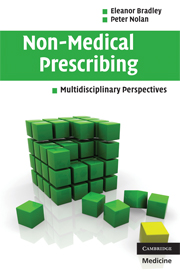Book contents
- Frontmatter
- Contents
- List of contributors
- Foreword
- Preface
- Acknowledgements
- Introduction
- 1 Medicines and prescribing – past and present
- 2 Nurse prescribing – impact, education and sustainability
- 3 Nurse prescribers: from 2003 to 2006
- 4 Nurse prescribing experienced
- 5 Nurse prescribing observed
- 6 Pharmacists and prescribing
- 7 Professions allied to medicine and prescribing
- 8 Conclusions
- Index
- References
Introduction
Published online by Cambridge University Press: 22 August 2009
- Frontmatter
- Contents
- List of contributors
- Foreword
- Preface
- Acknowledgements
- Introduction
- 1 Medicines and prescribing – past and present
- 2 Nurse prescribing – impact, education and sustainability
- 3 Nurse prescribers: from 2003 to 2006
- 4 Nurse prescribing experienced
- 5 Nurse prescribing observed
- 6 Pharmacists and prescribing
- 7 Professions allied to medicine and prescribing
- 8 Conclusions
- Index
- References
Summary
Among the many innovations in healthcare that came to the fore in the UK during the first decade of the twenty-first century was legislation allowing professionals other than doctors to prescribe for patients under certain conditions. Non-medical prescribing, as it is generally referred to, has been the focus of research, commentary and debate for some time. Although the number of prescribers has been growing steadily, those who opt to take on this role are still a minority within their respective professions. Some commentators have played down its significance; but others have seen it as symptomatic of a radically changing National Health Service (NHS) and a predictor of many more radical changes to come. There is little doubt that non-medical prescribing has the potential to change the concept and delivery of healthcare provision in the UK.
The idea of granting professions other than the medical profession prescriptive authority was first mooted in the UK in 1986. Although non-medical prescribing was initially restricted to community nurses, it has gathered rapid momentum during the first decade of the twenty-first century and has now extended to many more disciplines (Humphries & Green, 2002). Although time and resources were required to prepare personnel for prescribing, it was generally believed that the advantages of having non-medical prescribers would more than compensate for the effort of training them. Non-medical prescribers would, it was argued, provide more choice for patients and encourage well-informed debate about the benefits and drawbacks of pharmacological interventions (Luker et al., 1998).
Information
- Type
- Chapter
- Information
- Non-Medical PrescribingMultidisciplinary Perspectives, pp. 1 - 8Publisher: Cambridge University PressPrint publication year: 2008
